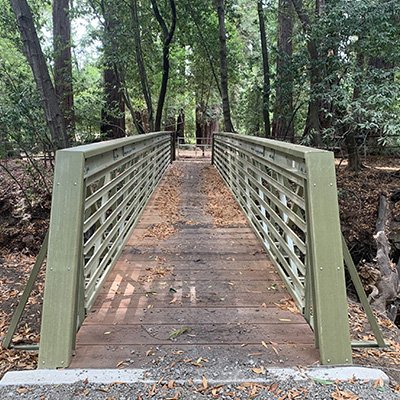Footbridges (a type of pedestrian bridge) are designed to be used for people, cyclists, and even animals. A footbridge connects two spaces for an easy passageway (i.e., connecting two pieces of land separated by a body of water).
This article will provide you information on three types of footbridges, the value they provide, and tips on how to design your footbridge.
3 Types of Footbridges
Footbridges can have a variety of design options to fit your needs and can be aesthetically pleasing. Below are three types of bridge designs that are used most often.
1. Truss Bridge
Truss bridges offer versatile design options. You can build them in almost any type of landscape, including parks, golf courses, nature trails, community areas, and more. The truss bridge’s long span design can range in size from 30 to -200 feet.
Depending on your specific design, truss bridges can accommodate vehicles if needed.
2. Beam Bridge
The beam bridge design, also known as girder bridges or stringer bridges, is a great economical option. Beam bridges are designed for shorter spans and are typically less than 30 feet long.
Depending on your specific design, beam bridges can accommodate lightweight vehicles if needed.
3. Suspension Bridge
The suspension bridge, or cable-stayed bridge, design is meant for larger areas, typically 200+ feet. This design features main cables or chains and is free-hanging (unlike truss and beam bridges).
This bridge can’t support any vehicles and will take a few years to plan and build because of its size.
What Makes Footbridges Valuable?
At its core, footbridges are crossing structures. They give people access to previously inaccessible locations, but they provide so much more value. Footbridges help connect people to nature so they can backpack, hike, mountain bike, horseback ride, and more.
Footbridges:
- Add an artistic element outdoors
- Connect different communities
- Ensure safe crossing over bodies of water, traffic, railroads, etc.
- Provide easier access for anyone who is disabled
Footbridge Design Planning
If you’re unsure where to start with designing your footbridge, ask yourself the following questions to narrow down your choices.
1. Where Am I Building the Bridge?
Determining your bridge’s location will guide you on the materials, design, dimensions, and more during the planning process.
2. How to Select the Best Material Option?
The most common bridge materials are wood, steel, aluminum, and fiber reinforced polymer (FRP). Understanding your bridge’s needs will help you select the best material.
3. Does My Bridge Need a Railing?
If you select the truss bridge or suspension bridge design, a railing will have to be part of the bridge’s design. If you choose to go with a beam bridge design, you have the option of whether to include a railing.
4. Do I Need a Long or Short Span Bridge?
The footbridge’s length needs to accommodate the environment. The bridge’s length could be determined from environmental elements (bodies of water, crossing a highway, etc.).
5. How to Calculate the Cost of the Bridge?
Multiple factors determine the bridge’s cost, including size, intended use (i.e., only pedestrian or light vehicle traffic), safety, labor required, and location. Please read our article about Calculating the Cost of a Bridge for more information.
Is a Footbridge Right for You?
To determine if a footbridge is best for you, reach out to Areté Structures. The Areté Structures team will work with you during the planning and design process.
Contact the Areté team here.
#1 – Truss Bridges
Truss bridges can be built in almost any type of landscape and can range in size from 30 feet to 200 feet. Their design can accommodate pedestrians, cyclists, and vehicles. Truss bridges are an ideal solution for long-span bridges.
#2 – Beam or Stringer Bridges
Beam bridges, also known as girders or stringer bridges, are ideal for shorter-span bridges (typically <30 ft). A side railing/handrail isn’t structurally necessary for a beam bridge. You can add a rail for safety or aesthetic purposes.
#3 –Suspension Bridges
Suspension bridges are long-span bridges and require significant design and construction resources. These types of bridges usually take a few years to plan and build.
Which one of the above types of footbridges is right for your project? Contact us here for a free quote.

